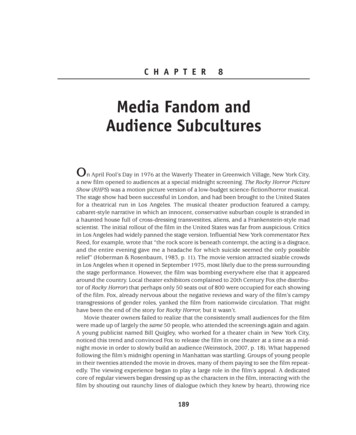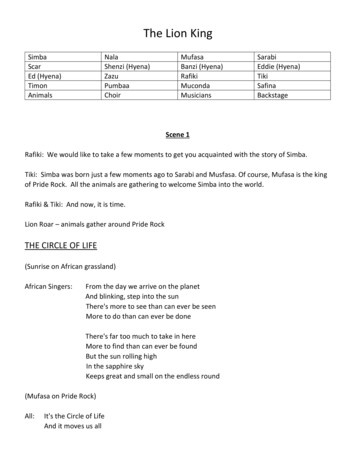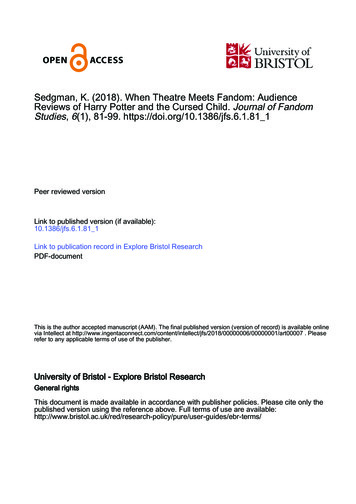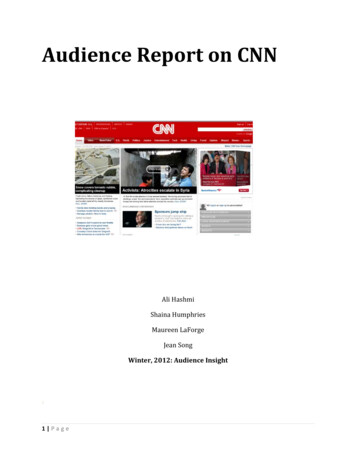
Transcription
C H A P T E R8Media Fandom andAudience SubculturesOn April Fool’s Day in 1976 at the Waverly Theater in Greenwich Village, New York City,a new film opened to audiences at a special midnight screening. The Rocky Horror PictureShow (RHPS) was a motion picture version of a low-budget science-fiction/horror musical.The stage show had been successful in London, and had been brought to the United Statesfor a theatrical run in Los Angeles. The musical theater production featured a campy,cabaret-style narrative in which an innocent, conservative suburban couple is stranded ina haunted house full of cross-dressing transvestites, aliens, and a Frankenstein-style madscientist. The initial rollout of the film in the United States was far from auspicious. Criticsin Los Angeles had widely panned the stage version. Influential New York commentator RexReed, for example, wrote that “the rock score is beneath contempt, the acting is a disgrace,and the entire evening gave me a headache for which suicide seemed the only possiblerelief” (Hoberman & Rosenbaum, 1983, p. 11). The movie version attracted sizable crowdsin Los Angeles when it opened in September 1975, most likely due to the press surroundingthe stage performance. However, the film was bombing everywhere else that it appearedaround the country. Local theater exhibitors complained to 20th Century Fox (the distributor of Rocky Horror) that perhaps only 50 seats out of 800 were occupied for each showingof the film. Fox, already nervous about the negative reviews and wary of the film’s campytransgressions of gender roles, yanked the film from nationwide circulation. That mighthave been the end of the story for Rocky Horror, but it wasn’t.Movie theater owners failed to realize that the consistently small audiences for the filmwere made up of largely the same 50 people, who attended the screenings again and again.A young publicist named Bill Quigley, who worked for a theater chain in New York City,noticed this trend and convinced Fox to release the film in one theater at a time as a midnight movie in order to slowly build an audience (Weinstock, 2007, p. 18). What happenedfollowing the film’s midnight opening in Manhattan was startling. Groups of young peoplein their twenties attended the movie in droves, many of them paying to see the film repeatedly. The viewing experience began to play a large role in the film’s appeal. A dedicatedcore of regular viewers began dressing up as the characters in the film, interacting with thefilm by shouting out raunchy lines of dialogue (which they knew by heart), throwing rice189
190SECTION 4 AUDIENCES AS PRODUCERS AND SUBCULTURESat the screen during a wedding scene, and dancing in the aisles during key musicalsequences. A scholarly study of Rocky Horror audiences conducted in Rochester, New York,found that roughly two thirds of the people waiting in line to see the film had already seenit once. The research also noted that the biggest draw for repeat viewings, aside from thefilm itself, was the audience participation that occurred in the theater (Austin, 1981). Fanclubs dedicated to RHPS began sprouting up all over the country, educating new fans aboutthe etiquette of audience response to various scenes in the film (see Figure 8.1 for a list ofexpected interactive practices for each showing of Rocky Horror). The film became a “cult”phenomenon through midnight showings in the United States and around the world, grossing over 100 million thus far. The primary draw for fans continues to be the socialFigure 8.1 Forms of Expected Audience Participation for The Rocky Horror Picture ShowSource: The Rocky Horror Picture Show Official Fan Site. http://www.rockyhorror.com/participation.
CHAPTER 8 Media Fandom and Audience Subcultures191e xperience of the film, which allows participants to interact with the screen and with eachother. The unique social environment surrounding Rocky Horror points to some of thefascinating ways in which fandom alters and even creates new cultural experiences out ofpopular media texts. These unique interactions between fans and media place theories offandom squarely in the sights of audience scholars.As we explored in Chapter 6, audiences actively interpret media content by producingmeaning out of the signs and symbols that make up the media text. These interpretationsare also closely connected to both the immediate and larger social contexts of audiences.The “transaction” (for lack of a better term) between the medium and the audience goesbeyond a single interaction with a television program, movie, or book. Imagine that youhave just finished reading a fiction book that you have found fascinating or inspiring. Youmight subsequently turn on your computer and find a fan website dedicated to the book,or perhaps an online chat room frequented by other readers who are as enthusiastic aboutthe book as you are. On one of these websites, you may even find that some fans enjoyed thenarrative so much that they inserted its characters into their own “fan fiction” writings.These short stories would be posted on online bulletin boards and websites for other fansto read and discuss. This hypothetical but common scenario demonstrates that our interactions with media texts today rarely have any clear boundaries. The expansive, malleablenature of the Internet and the declining cost of computers have allowed audiences to easilyextend their media experiences beyond the reception of the original text. Texts can bereinterpreted in many new and contrary ways: through connections to other audiencesonline, creation of new media texts based upon the source material, and—thanks to thepower of inexpensive computers to achieve professional-quality video and audio editing—even alteration of the original media text. As we will see later in Chapter 9, the latter activity often runs afoul of copyright law, and can pit even the most ardent media fans againstthe creators and media organizations that produced the media product in the first place.Overview of the ChapterThis chapter builds upon the audience interpretation and decoding theories presented inChapter 6, and explores the ways in which media audiences use their interpretive powerto actively subvert, distort, and even reimagine mainstream media content to suit their ownneeds and desires. We begin with the concept of media fandom: exploring how fan communities extend their interactions with media texts by logging on to discussions on theInternet, collecting artifacts associated with their media interests, and even by participatingin fan conventions and other related social activities. Fans are emotionally invested in theirfavorite media by thinking deeply about the plots, characters, and messages of those texts.They also reach out to other fans to discuss their mutual objects of affection, building“interpretive communities” around a particular media programming. Beyond activitiesdesigned to more fully appreciate the original texts (a television program or a film, forinstance), some fans go even further by modifying their favorite texts to suit their needsand interests. Fans of science fiction television programs such as Star Trek, Star Wars, andBattlestar Galactica have even translated their enthusiasm into elaborate social and textualsubcultures, producing their own media texts and challenging the interpretive authority of
192SECTION 4 AUDIENCES AS PRODUCERS AND SUBCULTURESmedia institutions in the process. Although there are numerous examples of these kindsof fan activities in relation to soap operas, mystery novels, and musical artists (just toname a few), this chapter explores previous research primarily on science fiction television programs. Do all of these fan activities mean that the balance of power betweenmedia and the audience has been tipped in the favor of individual audience members whocan reinterpret and even alter media texts to suit themselves? At the conclusion of thechapter, we will explore more recent scholarship on fandom, which revisits the conceptof a “fan” and calls into question the emancipation of audiences from media and culturalhierarchies in our society.DEFINING FAN CULTURESWhat is a fan? You might call yourself a fan of something such as a TV program, a sportsteam, a particular book, or a popular music group. We use the term in everyday parlance,but what does it really mean? Images of fans are ubiquitous in our popular media, andoften reveal a conflicting picture of the fan. For instance, there is the image of the geeky,socially challenged, but ultimately benign and lovable fan. We see this common stereotype in recent Hollywood films such as 2005’s Fever Pitch (with Jimmy Fallon portrayingan obsessed but ultimately reformed Red Sox fan) and in the fictionalizations of sciencefiction fandom such as 1999’s GalaxyQuest (centered on fans of a pseudo–Star Trek television program) and 2008’s Fanboys (the fictionalized exploits of a group of hardcore StarWars fans and their adventures in pursuing an advance screening of Star Wars I: ThePhantom Menace). This notion of the sweet but socially awkward fan exists alongside amuch darker view offered in films such as The Fan (1996), in which a baseball player isstalked and threatened by a violent sports enthusiast. Negative fan connotations are alsoassociated with figures in the news such as Mark David Chapman (a Beatles fan who murdered singer John Lennon in 1980, which some suggest was an outgrowth of his fanaticaldevotion to J.D. Salinger’s book The Catcher in the Rye) and John Hinckley Jr. (whoattempted to murder President Ronald Reagan in 1981, reportedly in a bid to impressmovie actress Jodie Foster).This somewhat shadowy, sinister image of the fan captures a fair amount of the essenceof the original etymology of the word. Short for “fanatic,” the term originally referred toreligious membership “of or belonging to the temple, a temple servant, a devotee” (Jenkins,1992, p. 12). It later turned toward much more negative connotations. Beginning in the17th century, the word described “an action or speech: Such as might result from possession by a deity or demon; frantic, furious” and later “characterized, influenced, or promptedby excessive and mistaken enthusiasm, especially in religious matters” (Oxford EnglishDictionary Online, 2000). The connections between fandom and religion are particularlynotable, as the usage of “fanatic” generally referred to an unwavering, uncritical belief in(usually religious) dogma. In Britain, the term “cult” media is often used to describe mediafan cultures. “Cult” also conjures up religious imagery, in an extreme and negative sense ofthe word. The Oxford English Dictionary describes “cult” as “a relatively small group ofpeople having religious beliefs or practices regarded by others as strange or sinister” (2000).
CHAPTER 8 Media Fandom and Audience Subcultures193The etymological roots of the word “fanatic,” particularly the connections to religious fundamentalism, fueled early negative stereotypes about fandom, portraying individuals asmisguided at best and delusional at worst.Fan StereotypesNegative notions of fans, seen through the lens of extremism and psycho-pathology,dominated the popular consciousness when scholars began to examine the phenomenonof fandom. In the early 1990s, media scholars such as Henry Jenkins (1992) and CamilleBacon-Smith (1992) attempted to correct this imbalance with their own ethnographicresearch into fans of the popular 1960s television series Star Trek. Jenkins, himself anavowed Trek fan, knew from his own experiences with other fans that the negative stereotypes with which they were associated were gross distortions of their attitudes and behaviors. For example, media fans are often portrayed as brainless consumers, willing to buyanything with a logo or image of their favorite media program or star. The popular culturalmaterials that fans tend to spend their time thinking carefully about are also seen by manyto be culturally worthless or simply there for entertainment purposes. Jenkins also discovered that media fans were often tagged as social misfits, intellectually immature, andfeminized. Concern has also been raised about the inability of fans to separate the fantasyof media texts from the reality of their everyday lives. In his touchstone book Textual Poachers, Jenkins looked beyond the popular stereotypes of fans by letting fans speak for themselves, conducting interviews, and examining fan textual productions. The range of fanactivities and interpretations uncovered by Jenkins and later scholars demonstrates thatfan audiences are deeply engaged in their favorite media texts. Fans often reinterpret mediacontent and create their own cultural productions in response.Defining Fan Studies: Why Study Fans?Before launching into any research project, scholars must define the subject underconsideration, and studies of fandom are no different. However, the definition of fandomhas been disputed among researchers who approached the field with competing agendas.Early fan studies set out explicitly to debunk many of the negative stereotypes that hadbeen associated with fan activities. For example, John Fiske noted that fandom is “associated with the cultural tastes of subordinated formations of the people, particularly thosedisempowered by any combination of gender, age, class, and race (1992, p. 30). Followingthe same line of reasoning that he presented in Television Culture (1987, see Chapter 6 fora full discussion), Fiske claimed that fans resisted their negative characterizations inpopular culture by establishing a sense of ownership over their favorite media texts, andengaging in interpretive play with those texts. The fact that fandom appealed to “subordinated” groups transformed fan participation into a kind of political resistance. Early scholars of media fandom were drawn to this notion because it challenged the idea of the“commodity audience” that we explored in Chapter 4. Instead of audiences’ viewingchoices being totally determined by institutional constructions, fans develop their ownsense of self-identity around their media consumption. This challenges the perceived
194SECTION 4 AUDIENCES AS PRODUCERS AND SUBCULTURESnegative stereotypes of the passive, unimaginative, or uneducated mass audience. Theactivities of media fans were envisioned as a corrective to the seemingly bleak top-downpicture of media power that emerged out of the political economic critique of audiences.Fandom was more than simple enthusiasm for a TV program or film; it was a form of collective interpretation of popular culture that created a powerful sense of group cohesion.For these scholars, “fan studies therefore constituted a purposeful political interventionthat sided with the tactics of fan audiences in their evasion of dominant ideologies, andthat set out to rigorously defend fan communities against their ridicule in the mass mediaand by nonfans” (Gray, Sandvoss, & Harrington, 2007, p. 2).Scholars in the later, so-called “second wave” of fan studies questioned the normativeconceptualization of fandom, because it seemed to be at odds with a great deal of mainstream enthusiasm across different sociodemographic groups for television programs, movies, and popular music. The category of “fan” has dramatically expanded as a result of theeven smaller niche media products and platforms available today (such as cell phone gamesand media, cable and satellite television channels, YouTube channels, and other forms ofmicro-media). Abercrombie and Longhurst (1998, p. 141), recognizing that there are perhapsdifferent levels of passion and involvement in fan activities, developed a continuum of audience experiences. Levels of engagement with popular media ranged from “consumer” onone end to “petty producer” (people who turn their fan activity into a profession and markettheir productions back to fans) on the other, with “enthusiast” and “fan” as levels of faninvolvement in the middle of the continuum (see Figure 8.2). Sandvoss (2005, p. 8) offereda more inclusive definition of fandom, taking into account both dedicated and casual fans.He defined fandom as “the regular, emotionally involved consumption of a given popularFigure 8.2Continuum of Fandom2consumerenthusiastcSource: Stephanie Plumeri.ontinfanuumofproducerfandom
CHAPTER 8 Media Fandom and Audience Subcultures195narrative or text in the form of books, television shows, films, or music, as well as populartexts in a broader sense such as sports teams and popular icons and stars ranging fromathletes and musicians to actors.” As Sandvoss’s definition demonstrates, we are all fans ofsomething in today’s media-saturated environment, which makes the cultural and sociological study of fandom all the more important for understanding media audiences.FAN CULTURES AND INTERPRETIVE ACTIVITYAlthough all audiences bring their own interpretive frameworks to popular media, the deepinterest and involvement in media content demonstrated specifically by fans has attractedthe close attention of scholars. Two aspects of media fandom have emerged as centralto theorists in this tradition. The first element is the social aspect, where media fansband together in either informal or more formally structured groups (such as fan clubs) toshare their mutual interest with others. Second, fans act as interpreters and producers ofmedia content, which we will call the interpretive aspect of media fandom. In this sectionof the chapter, we will explore some of the early systematic analyses of media fans, focusing on the social and interpretive aspects of fan cultures.The Social Aspect of Media Fandom:Developing Communities and SubculturesFans occupy an interesting position in society. They participate in many of the sametypes of social and textual activities that most media audiences engage in, but they havetraditionally existed more on the fringe of mainstream culture. Fan-related activities arebuilt largely around a close affiliation with the popular texts at the center of the enthusiasm. Fans of popular television programs, movies, or books will often spend a great deal oftime with their favorite texts, reading them closely and often repeatedly, looking for greaternuance and detail. However, audiences who are initially quite enthusiastic about their chosen media text want to do much more than simply consume the text. They want to sharetheir passion with others, debate the finer points of the text, integrate elements of themedia text into their own lives, and critique the text for any perceived deficiencies. Fansspread their enthusiasm by interacting with their peers in Internet chat groups, fan websites, and even informal and formal social gatherings. The more formal types of gatheringinclude elaborate conventions of fans held in hotel ballrooms and (increasingly) convention centers designed to accommodate thousands of people. Harrington and Bielby’s (1995)survey of 706 TV soap opera fans demonstrates the prevalence of this social element. Theyfound that 96% of those surveyed talked with other soap fans on a regular basis, and that37% of that large segment talked with four or more fans about their favorite program.Similarly, Bacon-Smith’s (1992) early study of women fans of the TV science fiction program Star Trek focused heavily on the kinds of social community that were establishedthrough their mutual affiliation with the program.The emergence of social groupings around a particular interest or activity isquite common. What distinguishes fans from other kinds of social groups (like stamp
196SECTION 4 AUDIENCES AS PRODUCERS AND SUBCULTUREScollectors or golf enthusiasts, for instance) are the subjects of their admiring gaze. Fansare not maligned due to the type of individual and collective activities in which theyengage (after all, sports fans are by and large celebrated in our popular media). Rather,negative perceptions arise because the materials that fans have selected to rally aroundare typically found on the low end of the cultural hierarchy. Therefore, the “ ‘scandal’stems from the perceived merits and cultural status of these particular works rather thananything intrinsic to the fans’ behavior” (Jenkins, 1992, p. 53). The selection and faninternalization of these mainstream cultural materials into their own personal lives (bydressing up as characters from their favorite TV shows or decorating their homes orplaces of work with paraphernalia from popular texts) distinguishes these individuals asa unique subculture. Fans who outwardly and proudly claim their affiliation with theirfavorite popular culture texts, particularly when those media are generally considered tobe “fluff” or mindless distractions from reality, may be challenging the status quothrough their activities.The notion of subcultures came into academic vogue following the 1979 publicationof Dick Hebdige’s book Subculture: The Meaning of Style. Hebdige argued that communities of punks, mods, hipsters, Rastafarians, and other groups dedicated to the specificmusical genres were distinctive cultural entities unto themselves. These groups challenged the authority of traditional mainstream British culture—not through any overtpolitical demonstrations or violent clashes with authority, per se, but through their clothing, pierced ears and noses, and other publicly visible signs (their style). These signs wereultimately unsettling and disruptive to the status quo. Hebdige noted that these symbolictransgressions “briefly expose the arbitrary nature of the codes which underlie andshape all forms of discourse” (Hebdige, 1979, pp. 90–91). Media fans are members ofsubcultures in the sense that they adopt their own linguistic codes (specialized ways oftalk, unique forms of greeting and address, and the use of codenames or titles, for example) and symbolic forms (including styles of dress) that delineate them from the rest ofthe population. For Hebdige and other British scholars who observed and analyzed subcultural groups in Britain (McRobbie & Nava, 1984; Willis, 1981), such forms of culturalexpression not only established a sense of self-identity for these groups, but also functioned as acts of emancipation from traditional authority. Early scholars of media fandomsuggested that fans, while not necessarily posing the kind of threat to traditional culturalauthority that punk music did in the 1970s and ’80s, still challenge existing hierarchiesby redeeming “trashy” cultural forms like TV soap operas, science fiction programs, horror films, and mystery novels.Fan Activism: Challenging Institutional ProducersAs Hebdige’s analysis suggests, the function of social interaction among fans is notmerely to spur a deeper appreciation of the original text. Close-knit communities of fanscan also offer direct challenges to existing authority. Fans can be mobilized to press producers and media corporations for change (or, as is more often the case, to preventchanges from coming about in a favorite media text). This kind of activism often servesas a rallying point for fan movements. The groups solidify a sense of mission and purpose
CHAPTER 8 Media Fandom and Audience Subcultures197for themselves, which can have the mutually reinforcing effect of expanding their ranks.One of the clearest examples of fan activism centered on the 1960s science fiction television series Star Trek. The original Star Trek television series, which premiered on NBC onSeptember 8, 1966, followed the exploits of the crew aboard a quasi-military spaceshipcalled the Enterprise. The series, conceived by creator Gene Roddenberry, was designedto be a kind of western in space (Roddenberry once claimed that the program wasdesigned to be a “Wagon Train to the stars,” referencing the title of a popular westernprogram on NBC at the time) with a moral message at the end of each show. Although theprogram dealt with interesting groundbreaking themes and won accolades among somescience fiction audiences, it was in danger of cancellation almost from the outset due tolackluster ratings.The threat of cancellation of this new outer space TV series galvanized what was tobecome one of the largest and most enduring media fan movements in the world. Whenword of the impending cancellation of the series leaked out in 1967, both Roddenberryand a group of science fiction fans began to organize an extensive letter-writing campaignto help save the program. Two fans, John and Bjo Trimble, even wrote an advice sheet forwould-be fan petitioners called “How to write Effective Letters to Save Star Trek.” Theydirected fans to send these letters to the president of NBC, to NBC affiliate TV stations, toTV columnists, and to TV Guide (Messenger-Davies & Pearson, 2007, p. 218). According toan NBC press release, the network received over 115,893 letters in response to the cancellation announcement—a surprisingly large response for such a small program—and NBCrenewed the program for a third season. The fans were elated, with Bjo Trimble proclaiming, “And so a major triumph of the consumer public over the network and over the stupidNielsen ratings was accomplished through advocacy letter-writing” (Trimble, 1982, p. 36).However, the fans’ victory was short-lived. In January 1969, a 50% drop-off in viewer ratings led NBC to again cancel the program, this time for good.Despite the disappearance of the original media text from American television screens(and, indeed, because of it), the community of fans devoted to Roddenberry’s space adventure series expanded dramatically in the years following its cancellation. In February 1972,fans organized the first formal convention of Star Trek enthusiasts in the ballroom of NewYork’s Statler-Hilton Hotel. They expected several hundred attendees, and were astonishedwhen more than 3,000 actually showed up to see many of the original cast members fromthe now-defunct series in person (Tulloch & Jenkins, 1995, pp. 10–11). More than 6,000people attended the New York convention the following year, and many similar Star Trekconventions emerged in other cities around the country (Tulloch & Jenkins, 1995, p. 11).The success of the fan-as-activist model in the case of Star Trek spurred passionate followers of other television programs, including soap operas (see, for example, Baym, 2000;Harrington & Bielby, 1995; Scardaville, 2005), to form fan organizations in response to thethreat of cancellation due to a program’s lack of commercial viability. However, mostattempts to alter media producers’ decision making have been failures. For this reason,Tulloch and Jenkins refer to fans as a “powerless elite.” This phrase defines fans as “structurally situated between producers they have little control over and the ‘wider public’whose continued following of the show can never be assured, but on whom the survival ofthe show depends” (1995, p. 145).
198SECTION 4 AUDIENCES AS PRODUCERS AND SUBCULTURESFans and Media Texts: Protecting Continuity and CanonWhen fans connect to other enthusiasts through face-to-face or online interactions,they immediately share a common bond of fascination with, and knowledge of, a particular media text. Fans abandon any sort of critical distance from their favorite media.They experience these texts in a much deeper way by integrating them into their lives.1As Jenkins (1992, p. 56) notes, “The difference between watching a [television] series andbecoming a fan lies in the intensity of their emotional and intellectual involvement.”Through close interpretation and re-reading of the text and spirited debates and discussions with others, fans develop an extensive repertoire of knowledge about their favoritemedia. Although these “trivia” details about popular media are not necessary for casualaudiences to obtain entertainment from popular media, the utilization and trading ofthese extensive volumes of knowledge about popular texts are key sources of fan pleasure. Fan audiences may feel so connected to the narrative that they revere that theydevelop a sense of ownership over the text. This places these audience members on ahead-on collision course with the producers and copyright holders, who have a vestedinterest in developing the characters and storylines in particular ways. When the interestsof fans and media creators diverge, controversy and struggle emerge as important aspectsof the media-audience relationship.Fan audiences pay special attention to the details and nuances of their favorite texts,dissecting them with care and discussing them at length with other fans. Science fictiontelevision, in particular, demands from viewers a willingness to understand and accept howa particular universe operates (whether it is futuristic or in another part of the galaxy withalien species) and how the characters in that universe interact with one another. Fans revelin the details of the workings of the fictional world and amass a storehouse of knowledgeabout the program. This information is collected from external sources like fan magazines,general interest media, blogs, chat rooms, and fan websites. Viewing favorite televisionprograms over and over again is therefore an important aspect of fan cultures. It helps notonly to internalize details about the narrative but allows individuals to experience the thrillof seeing the narrative for the first time all over again. It also allows those viewers to discussideas about the narrative with other fans. As Jenkins notes, “rereading is central to the fan’saesthetic pleasure. Much of fan culture facilitates repeated encounters with favored texts”(1992, p. 69).The result of intense fan interest in popular television shows is that the producers of thoseprograms have to tread carefully whenever they decide to alter the fundamental outlines ofthe narrative or to develop characters in specific ways. An awareness of the character and plotdevelopment of a particular program is called
fiction fandom such as 1999’s GalaxyQuest (centered on fans of a pseudo– Star Trek televi - sion program) and 2008’s Fanboys (the fictionalized exploits of a group of hardcore Star Wars fans and their adventures in pursuing an advance screening of Star Wars I: The Phantom Menace). Thi










